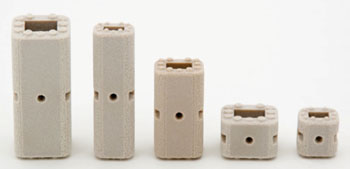3-D Spinal Implant Replaces Damaged Vertebrae
By HospiMedica International staff writers
Posted on 05 Aug 2015
A novel three-dimensional (3-D) printed implant replaces collapsed or unstable vertebrae in the thoracolumbar regions of the spine stemming from tumor or trauma.Posted on 05 Aug 2015
The SpineFab vertebral body replacement (VBR) implant system is 3-D printed in 48 sizes using laser sintering high performance additive manufacturing (HPAM) and a proprietary high performance polymer powder formulation, polyetherketoneketone (PEKK), a semi-crystalline thermoplastic that is chemically inert and non-absorbable. The material offers a unique and beneficial set of attributes, including radiolucency, a density and stiffness similar to bone, excellent abrasion resistance, minimization of detrimental stress shielding, and compatibility with most common sterilization methods.

Image: The SpineFab VBR implant system (Photo courtesy of OPM Biomedical).
The load-bearing PEKK formulation has twice the compressive strength of polyetheretherketone (PEEK), and also underwent extensive static and dynamic mechanical testing to assure it meets load and fatigue requirements; the same PEKK formulation is used to print individualized cranial and facial implants. The SpineFab VBR implant system is a product of Oxford Performance Materials Biomedical (OPM Biomedical; South Windsor, CT, USA), and has been approved by the US Food and Drug Administration (FDA).
“We have built a strategy with the patient in mind by working together with clinicians to bring innovative device solutions that anticipate improved surgical outcomes,” said Severine Zygmont, President of OPM Biomedical. “Our OsteoFab process, which combines 3D printing with a unique material chemistry, is causing the industry to rethink how implants are designed and manufactured. We can now envision devices that will promote bone tissue formation while being imaging friendly and anatomically desirable.”
Related Links:
Oxford Performance Materials Biomedical














